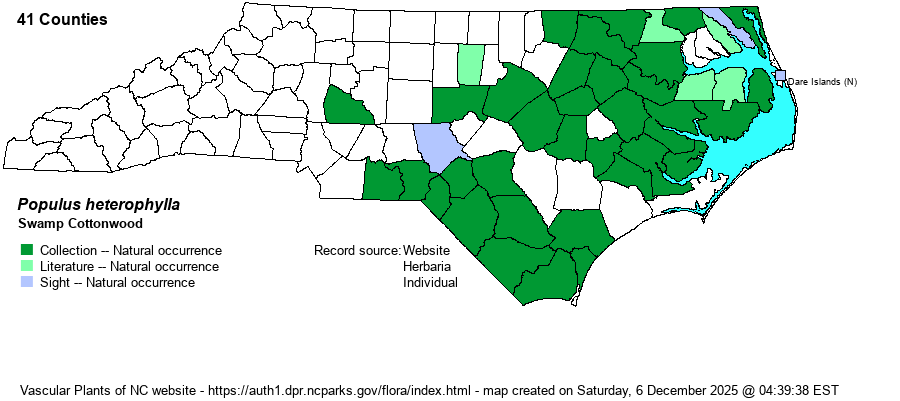| Author | L. | |
| Distribution | Essentially throughout the Coastal Plain, and into the eastern portion of the Piedmont, rarely as far inland as Rowan County.
This species has a very oddly bimodal range. It occurs in Atlantic states essentially in the Coastal Plain, from MA to extreme eastern GA. It then occurs from the FL Panhandle west through parts of AL and MS north up the Mississippi River floodplain to southern IL, southern MI, and OH. It is not found in WV, nearly all of GA, and most of FL.
| |
| Abundance | Fairly common to locally common in the Coastal Plain, but not one of the more common or widespread species of Coastal Plain floodplains and wetland forests. Rare to very uncommon in the narrow Piedmont range. | |
| Habitat | This is a species of both brownwater and blackwater swamps, but it can be somewhat local in occurrence. It does occur in bottomlands, but mostly where wet and verging on swamps. It also occurs around wooded pools and depressions. For whatever reason, one can often see many saplings and young trees along edges of such wetlands, yet can have difficulty finding large parent trees nearby. |
| Phenology | Blooms and fruits in March and April. As with Eastern Cottonwood (P. deltoides), the feathery white fruit are often seen blowing or drifting though the forests in early spring, as if snowflakes. | |
| Identification | This is a medium to large deciduous tree, to 90-100 feet tall, but it can be difficult to find large trees. It has some of the larger leaves of swamp plants, with them being ovate to somewhat triangular in shape and with gently tapering (and convex) margins to a somewhat rounded tip. Leaves can often be over 6 inches long, and the leaf bases are usually squared-off to rounded. The similar Eastern Cottonwood, which may grow with it, has flattened leaf petioles, as opposed to rounded in this species; the leaves average smaller in size, as well. And, the former has strongly triangular leaves with acuminate tips. Though it is not difficult to find this species along swamp or wet bottomland margins, the number of truly tall cottonwood trees seems proportionally small to the number of saplings seen. | |
| Taxonomic Comments | None
| |
| Other Common Name(s) | Downy Poplar, Swamp Poplar, Black Cottonwood. The genus Populus has species named as poplars, aspens, and cottonwoods; thus, the last part of the common names of these trees may vary among these three terms. | |
| State Rank | S4 | |
| Global Rank | G5 | |
| State Status | | |
| US Status | | |
| USACE-agcp | OBL link |
| USACE-emp | OBL link |

